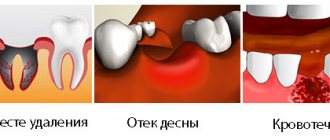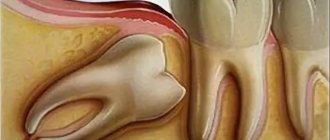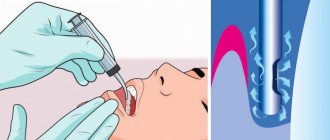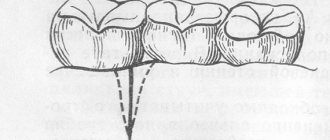The question often comes up on various forums: “what to do if the gums are swollen or swelling appears around the tooth”? In this case, there may be various accompanying symptoms: there may be pain in the gums, or there may not be; there may be a fistula, or there may not be; a tooth may hurt, gums may bleed, and there may be many other symptoms. Treatment of swollen gums in Samara directly depends on the reason for the swelling on the gums.
In this article, we will try to figure out what can cause swelling on the gums, what symptoms other than swelling can help determine the cause of this swelling, and what to do at home until you can see a dentist.
Why gums may swell, causes of swelling
- Exacerbation of periodontitis;
- Exacerbation of chronic periodontitis or gingivitis;
- Abscess.
Of course, these are not all possible causes of swelling on the gums, but about 90% of requests (if not more) fall within this framework.
What to do if your cheek is swollen after tooth extraction?
Often after a tooth extraction procedure, many people experience swelling that may persist for some time.
Its appearance is natural, since tooth extraction is essentially a surgical operation, after which the wound remaining in the oral cavity remains open. It recovers fairly quickly, but damaged gum tissue will remain swollen for some time. The size of the tumor may depend on several factors, such as the complexity of the removal procedure, the individual characteristics of the person, and the professionalism of the dentist.
How gums heal
After surgery, connections between tissues and cells are disrupted. The healing process is the formation of new physiological and anatomical connections between them.
Healing includes:
- Formation of a blood clot - forms within 5-10 minutes after surgery and serves as a protective barrier against infection and harmful microbes.
- Formation of granulation tissue - within 3-4 hours the production of granulation tissue (young connective tissue) begins.
- Epithelization and collagen formation lasts up to 7–10 days and is sometimes accompanied by slight itching.
- Regeneration and maturation - the wound “heals” after 2–3 weeks, but complete healing of the fibers requires several months.
Gum healing
Signs of a tumor that is not dangerous to health
- swelling of the gums and cheeks does not increase and does not have a pronounced form;
- after removing a tooth that caused severe pain, or a wisdom tooth, discomfort and pain should gradually subside;
- even if during the removal procedure you had a slight fever, it should no longer be present, and in no case should it rise;
- there is no unpleasant odor from the hole, which may occur in case of complications.
The cheek tumor can reach its maximum size the day after tooth extraction. Then the swelling should subside.
What to do after the procedure
General recommendations:
- when you arrive home, you just need to lie down and relax;
- you cannot eat or drink for 3 hours;
- for 3 days after surgery, you should not open your mouth too wide, or eat hard or hot foods;
- limit emotional and physical stress;
- hot baths, visiting the sauna, and exercising in the gym are prohibited;
- It is advisable to completely stop smoking and drinking alcohol for a week.
Remember: under no circumstances should you apply hot compresses or burn the wound with alcohol, iodine or brilliant green. It will only get worse!
A dental surgeon can prescribe applications of wound healing and antimicrobial ointments (Cholisal, Solcoseryl, Stomatofit, etc.). To strengthen general immunity, you can take immunomodulating agents and multivitamin complexes.
How to remove swelling of the cheeks and gums
If the tumor does not cause particular concern, then it is a natural phenomenon after tooth extraction.
There are ways to relieve pain and reduce swelling, as long as it is not harmful to health.
- It is necessary to apply cooling compresses to the inflamed cheek several times during the day, this can be a bottle of cold water, ice in a cloth, a damp towel, which should be kept for twenty minutes, periodically cooling it in cold water. You will immediately feel relief and notice how the tumor decreases in size.
- People with high blood pressure are more susceptible to post-operative swelling. They are recommended to take sedatives and blood pressure-normalizing medications after tooth extraction.
- Conventional anti-edema products can relieve swelling well - gels, creams, ointments that can be applied to the outside of the cheek.
- To relieve pain, which is inevitable after complex removals, you can take a painkiller (except aspirin) or an anti-inflammatory drug and lie down to rest.
Flux and great swelling. What to do after a gum incision?
My son has a lot of swelling and, of course, gumboil. Yesterday we went to the doctor, they opened his gum. We started taking the antibiotic doxycycline and rinsed with chlorhexidine, as the doctor who made the incision said.
But I want to ask you: the swelling is very large, almost up to the eye, what to do in this case? And how will the swelling go away? At least tell me approximately. And what else can you do?
The doctor made a relieving incision to relieve the exacerbation. Subsequently, the cause of the swelling must be determined and treated. The swelling should go away within 3-4 days. See your doctor again for an examination.
Contact phone number
Comments and reviews 32
My daughter (6 years old) had swollen gums, so we went to the dentist. The doctor removed the filling and the pus drained out. She prescribed rinsing the tooth cavity and Sulfadimethoxin tablets. We do everything and drink, but the tooth hurts and the gums are still swollen. On what day should the swelling on the gums subside, or should I go to the doctor again? Answer
An examination and a targeted x-ray are required. It is possible that the tooth cannot be treated and will need to be removed or the treatment plan adjusted. Everything is individual. Swelling of the gums may subside for 2 days or more. It is better to consult in person with a pediatric dentist. Answer
General dentist
The tooth is broken, only slightly sticking out, the cheek is swollen, i.e. gumboil has appeared. I assume that they will cut the gum. Tell me, how painful is it to cut the gum? I know that with gumboil, painkilling injections do not help much. And what actions will follow next? I'm very afraid. Answer
At the moment, a large number of painkillers have appeared; it is not at all necessary that there will be severe pain. In any case, the longer you delay a visit to a specialist, the more difficult and painful the manipulations will be. It will be necessary to remove the causative tooth, open the purulent-necrotic process, create drainage for the outflow of contents, and a course of antibiotic therapy and other medications will be prescribed. Answer
General dentist
Help me decide if I should panic. The tooth was destroyed, it was rooted, it began to bother me, and the gums underneath it were swollen. I came to the hospital, the roots were removed, an incision was made, and a drain was installed. After a couple of hours, my cheek became swollen, and after two days the swelling subsided. Nothing hurts. But the gums were densely swollen and remained, even more than before removal, the drainage has not yet been removed. Is this the norm or not? Answer
Some swelling after removal is normal for some time; it is important to follow the recommendations of your doctor and arrive on time for your appointments. Maintain oral hygiene, rinse your mouth with an antiseptic (miramestin, chlorhixedine) after eating, unless there are contraindications to these drugs. Answer
General dentist
Hello, I went to a specialist with flux and acute pain, as a result of which two teeth were removed and the gums were opened, drainage was not installed (5 days ago). I feel a dull pain, the gums are swollen, there is a white coating in the sockets, is this normal? Answer
It is worth contacting a specialist again for an examination. The described picture is characteristic of a relapse (i.e., resumption of the inflammatory process). The presence of plaque on the tongue, swelling and pain indicates the presence of a purulent-inflammatory process. Answer
General dentist
Good afternoon Yesterday I was diagnosed with a flux, but no drainage was installed. The cheek tumor appeared in the morning and is accompanied by a dull pain and a temperature of 37.3. I went to the doctor, he looked at it and answered that this is how it should be. Is it so? How long? Why didn't they install drainage? Answer
Without a clinical examination it is impossible to make a clear judgment. Drainage may not be installed if the created outflow is sufficient. Typically, a low-grade fever may persist for several days, but swelling should decrease. Answer
Yesterday I was diagnosed with a flux, but no drainage was installed. The next morning, my cheek became swollen, accompanied by pain and a temperature of 37.3. Today I went to the doctor again. The doctor replied that it should be so. I take antibiotics. Why didn't the doctor install drainage, how long will the swelling and pain last? Answer
Drainage is installed according to indications, based on the initial clinical picture. Pain and swelling after opening the flux can last up to 7 days. You should follow all recommendations of your dentist. To relieve swelling, you can use antihistamines. Answer
General dentist
Today they cut my gums because I had gumboil. The tooth was not removed, after 1 hour a large amount of clot began to collect under my lip. I would say a very large number. Should it be like this? Answer
It is impossible to judge without a clinical examination. If drainage conditions are created, the exudate leaves the periapical tissue. Answer
General dentist
At the first consultation, the dentist prescribed Cifran 500, took it for 2 days, and the swelling did not go away. I had to open the gum. Another doctor prescribed Amoxicillin and took it for 2 days. What is better to drink now after opening the gumboil? Answer
It is impossible to change antibiotics from one to another without drinking the full course of treatment. Consult in person with a dental surgeon; opening the flux is not enough; it is necessary to eliminate the problem and cure the causative tooth. An antibiotic can be prescribed only after studying the history of life and disease. Answer
General dentist
Today I had surgery on my upper wisdom tooth. They removed the tooth, made an incision, and installed a drainage rubber. An hour after visiting the surgeon, a tumor appeared in the temple area. Within an hour I slept heavily and was barely visible. How does this relate to flux? The tumor did not reach the temple. Answer
Yes, this may be associated with an inflammatory process in the periapical tissues. If there is drainage, the exudate will exit through it. Answer
General dentist
I am treating a difficult tooth. After the gum incision, rinsing was prescribed. I rinsed my mouth with Chlorhexidine immediately after brushing my teeth. The tongue is numb and tingling. The night passed, but so did the feeling. Will this pass? Answer
Yes, the discomfort should go away within two days. Answer
Contraindicated actions for swelling:
- Under no circumstances should you heat the swollen area, or touch the wound with your hands and tongue;
- rinsing on the first day after tooth extraction is not recommended, as it can wash away the blood clot that protects the socket from infections. In the future, you can rinse your mouth with antiseptic solutions - miramistin, furatsilin, or decoctions of chamomile, sage;
- the first two to three hours after the removal operation, you should refrain from smoking, drinking and eating;
- Until the wound is completely healed, you should not consume solid food, hot and carbonated drinks, or alcohol.
If you follow these simple rules, the swelling will go away quickly enough and there will be no need to visit the dentist.
Gum incision: indications, care, when the wound heals
Unpleasant sensations when visiting the dentist arise not only from the unpleasant sound of the drill or the grinding sound when a tooth is removed. Sometimes an incision is made in the patient's gums. The causes and consequences of this are varied. The operation requires preparation and creation of conditions to ensure better healing of the gum after its incision.
In what cases is the gum cut?
A simple gingival incision is often confused with a resection. The latter is not just an incision, but an excision of the gum, removing part of it.
Dissection of the gum consists of opening it with a sharp instrument in the following conditions:
- purulent lesions - gumboil, periodontitis, abscess, phlegmon;
- infections at the root of the tooth – periostitis, periodontitis;
- implantation of a denture;
- a gingival hood over a wisdom tooth due to its slow eruption and abnormal growth.
In all these cases, gum resection may be required if the surgeon discovers excess tissue or determines that it is impossible to restore it conservatively.
Gum excision
Excess gum tissue or tissue that cannot be restored is cut off:
- In case of violation of the eruption of molars - their retention, pericoronitis.
- If there are pathological formations at the root apex - cysts or granulomas.
- If an abnormality in root development is detected during tooth extraction.
- If the crown is destroyed - to ensure the removal of all fragments.
- For inflammation leading to non-viability of the gums - periodontal disease, gingivitis, periodontitis.
Removing tissue promotes better gum restoration.
Indications and contraindications
Most often, the indication for an incision is the need to ensure the drainage of pus from the area of inflammation.
The gums are incised to remove a tumor, cyst, or foreign body, for example, a stuck bone.
To install fasteners during dental implantation, with impacted teeth, when braces do not help, the gums are also sometimes cut.
When using veneers, the gum sometimes moves away from the tooth. Then gum plastic surgery is indicated, which is performed with an incision.
Relative contraindications for incision are:
- Allergy to local anesthetics. If an incision is unavoidable, the surgeon selects the anesthetic to which the patient does not have an allergic reaction.
- Unsanitized oral cavity. Before the incision, it is sanitized.
- Acute infections are a contraindication only for elective gum surgery. For purulent inflammations, when urgent intervention is needed, it is done under the guise of antibiotics.
- HIV infection. The operation is performed against the background of immunomodulators.
- Oncology. The intervention is carried out after antitumor treatment.
- Diabetes. Before and after the gum incision, it is necessary to treat the wound with drugs that promote tissue healing, for example, Solcoseryl.
- Mental disorders of the patient that prevent adequate communication. Then anesthesia is used during the intervention.
- Blood clotting diseases. The incision is made against the background of anti-clotting agents.
Stages of the operation. How to cut gums in dentistry
No matter how the gum is cut, the procedure is the same:
- Examination and antiseptic treatment of the oral cavity, professional cleaning, and, if necessary, radiography.
- Anesthesia - local or anesthesia.
- Selecting the type of cut and the cut itself.
- Basic treatment methods: installation of a drainage system in the wound to release purulent exudate for up to 3 days, removal of a tumor, cyst, installation of prosthetic elements.
- Stitches are applied and removed within 5–7 days.
Before surgery, preparation is often carried out with immunomodulators, restoratives, anti-inflammatory, and antiallergic drugs. After surgery, antibiotics may be prescribed for 3–5 days due to the risk of purulent inflammation.
There are a number of methods for cutting gums.
A vertical incision from the edge of the gum (gingivotomy) is usually performed for periodontitis.
In flap dissection, a series of horizontal and vertical incisions are made. This type is divided into the following stages:
- coronal displacement with detachment of a tissue flap and covering of the exposed dental root system with it;
- formation of a lateral flap to cover isolated small areas of exposed roots, for example, with periodontal disease;
- the most traumatic V-shaped incision with the addition of donor gum tissue to the resulting flap to cover not only a small, but also a larger area of the exposed root;
- the Ramfjord method for accessing the diseased root - the gum is dissected at the periodontal pocket, the edges of the flap are moved apart and returned to their place after removing the affected tissue;
- cross-shaped incision for flux.
Flap surgery
The surgeon chooses the type of incision that is justified in a specific clinical situation.
How long does it take for gums to heal after an incision? How long does it take for the swelling to go down?
In order for the gums to heal, after surgery a blood clot must form in the wound within 10–12 minutes. It prevents pathogenic bacteria from entering the incision site and after 3-4 hours it is converted into granulation - young gum tissue. Epithelial coverage occurs by 10 days, and healing of the wound occurs within 2–3 weeks. It will heal completely in two months.
Healing times are determined by a number of factors and increase:
- proportional to the volume of surgical trauma;
- with age;
- with low immunity;
- for underlying diseases (diabetes, inflammation, HIV, oncology).
Applying sutures speeds up the healing of the wound edges brought together by the sutures.
How many days the swelling will go down depends on the extent of the operation:
- in case of injury to a large area, the swelling does not subside for several days;
- the presence of purulent inflammation before surgery prolongs the period of tissue swelling until all the pus comes out, so drainage is left in the wound for several days;
- when installing implants or prosthetics, cheek swelling can last up to 1 week, but if it grows or increases pain, you need to consult a dentist - perhaps the installation was incorrect;
- If there are complications, the swelling will not subside and will increase - this is a signal for an urgent visit to the dentist.
A condition where the cheek is swollen after surgery is considered normal if the bump lasts no more than 3-5 days. Otherwise, you need to consult a surgeon.
How to rinse your mouth after a gum incision
Rinsing the mouth after surgery is not done immediately, so as not to wash out the blood clot from the wound.
They use pharmaceutical products: chemical and herbal, as well as those prepared at home.
Home Remedies
| Ready-made products | ||
| Chemical | On herbs | |
| Chlorhexidine | Stomatophyte | Infusions: take 1 tbsp. for 1 tbsp. boiling water, leave for 15–30 minutes, strain, cool, add to a volume of 200 ml |
| Miramistin | Maraslavin | Saline or soda-salt solution (1 teaspoon each of soda and salt, preferably sea salt, per 1 cup of water) |
| Furacillin | Rotokan | Light pink solution of potassium permanganate |
In addition to general recommendations, the doctor will advise what to rinse the mouth of a particular patient.
You need to rinse after each meal until swelling and pain disappear. Sometimes the same products are used for applications and lotions on the incision area.
Complications after surgery
Complications of gum incisions include:
- fever, indicating current inflammation;
- swelling of the gums;
- boring, burning pain radiating to the jaw bone, ear;
- bleeding 1–2 hours after surgery;
- flux.
Self-medication here is dangerous, since any of the complications may require repeated incision of the gums.
Edema and swelling
Swelling at the wound site for 2–3 days is acceptable. If it spreads to the cheek, this may be a sign of alveolitis - inflammation of the socket, requiring repeated intervention.
Heat
With normal healing, the temperature gradually drops by day 4–5. If it lasts longer and becomes higher, the wound has become infected and a new operation is needed.
The pain gradually subsides. When it increases, the appearance of a new character, severity, coupled with swelling and high temperature, surgical treatment of a purulent infection is required.
Bleeding
When the gums are cut, bleeding occurs after 1–2 hours. Homemade hemostatic agents are used: hydrogen peroxide, applying a tampon to the wound. If the patient sees that the bleeding does not stop, urgent assistance from a dentist is needed.
With increased pain and swelling, inflammation can spread to the periosteum of the jaw, and gumboil occurs. Surgical treatment is needed.
Recommendations after gum incision
After the operation, the dentist will tell you what can and should be done, and what it is better to refrain from.
- Do not eat or drink for 3–4 hours, do not touch the wound with your tongue, and do not rinse your mouth on days 1–3. Baths with antiseptics and application of gel are possible - Solcoseryl, Cholisal, Kamistad, from the 3rd day - rinsing.
- During the week, use gentle, soft food.
- Eliminate physical activity on the 1st day, alcohol and smoking for a week.
- Any warming (bath, sauna, swimming pool, compresses) and cauterizing procedures (alcohol, iodine, brilliant green) are prohibited for a week.
- If you have sutures, you should not open your mouth too much when eating or talking.
- For pain, take a painkiller (Analgin, Ibuprofen, Ketanov), apply cold.
- After a week, as prescribed by the doctor, physical therapy (electrophoresis, UHF, magnetic laser, paraffin applications) is possible, which improves regeneration.
Following the doctor’s recommendations will help avoid complications and ensure rapid healing of the incision on the gum.
Sources: https://topdent.ru/vopros-otvet/flyus-i-bolshaya-otechnost-chto-delat-posle-nadreza-desny.html https://azbukazubov.com/parodont/desna/zachem-drenazh-v -desne.html https://desnazub.ru/lechenie/razrez-desny-pokazaniya-uhod-chem-poloskat https://stomaget.ru/hirurgiya/opuhla-shheka-posle-udaleniya-zuba
When to see a doctor
If you have followed all the rules, carried out all the procedures aimed at reducing swelling, and your condition continues to worsen, then this is a sure sign that you need to urgently consult a dentist. Immediate medical attention is required if:
- the next day the swelling increased, and the pain did not decrease;
- the temperature has risen, general health has worsened;
- opening the mouth is accompanied by painful sensations, and the smell of rotting from the hole is felt.
All these symptoms should prompt an immediate visit to the dentist to avoid serious consequences.











